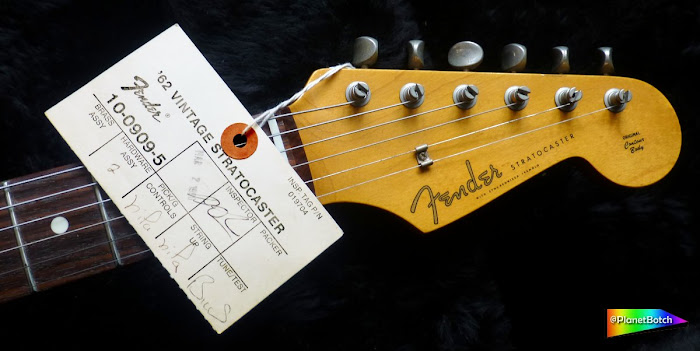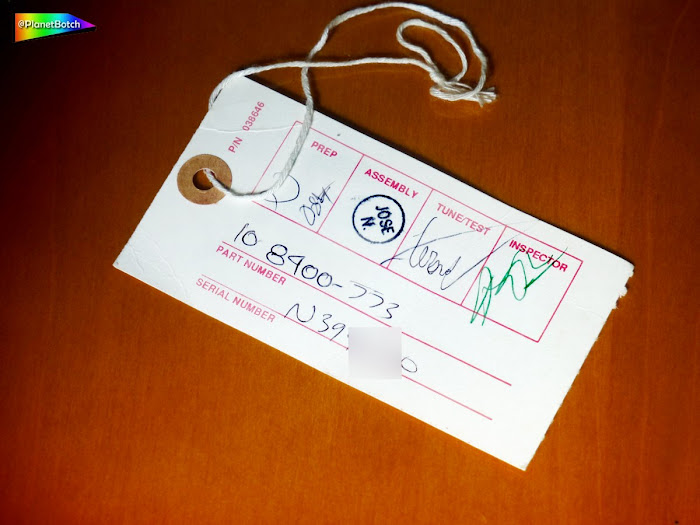
Showing the model code 10-0909, a Fender USA '62 Vintage Reissue Stratocaster inspection tag from March 2nd 1990.
How obsessive are you about guitar collecting? Do you insist on as-new instruments with their original tags? If so, one piece of maker's tag cross-referencing data you'll be used to noting is the universal Fender model code.
In this post I'm going to explore the classic 1990s model code system, from the period when the USA-made line-toppers shared the market with Japanese, Mexican and Korean Fenders or Squiers.
THE DIFFERENCE BETWEEN MODEL CODE AND SERIAL NUMBER
Model codes are distinct from serial numbers. The serial number is a unique reference for an individual guitar. In contrast, the model code identifies every guitar with a particular set of specifications. So, for example, every right-handed, 1993 Fender American Standard Telecaster with a rosewood fingerboard would have exactly the same model code: 10-8400. The maple-necked version would be 10-8402, and the left-hander (only available with a maple neck) would be 10-8422.
This was the format in which the numbers would normally appear on the official Fender inspection tags, as found hanging from a brand new instrument's headstock on a retailer's rack. At the beginning of the 1990s, the codes were printed onto the tags in hard, hyphenated form. But later, the codes were written on by hand, sometimes with the prefix and suffix joined together (i.e. 108402), or with a gap, instead of a hyphen, between prefix and suffix (i.e. 10 8402).
In Fender literature, however, the model codes would be catalogued with an added zero at the beginning. So USA Standard Tele 10-8400 would be documented as 010-8400.
THE DIFFERENCE BETWEEN JAPANESE AND AMERICAN CODING

Fender Japan Telecaster: model TL62B-80 under the Japanese coding, and model 027-5100 under the Fender USA universal coding.
Before I go any further, I also want to distinguish these Fender USA codes from the separate, and less specific coding system used by Fender Japan. The Fender Japan codes visibly recognised the guitar model name in two-letter form, along with a year designation if the guitar was a reissue, and then a pricing tier identifier, in thousands of Yen. If the guitar was not a reissue, there would be no year designation. For example...
Model TL62B-80 - shown above - was a Telecaster (TL), with 1962 year spec (62), a bound body (B), and a price tag of Y80,000 (80).
Model SST-33 was a Squier (S) Stratocaster (ST) with no vintage year spec, and a price tag of Y33,000 (33).
Totally logical. But the problem was that these Japanese model codes did not recognise the difference between, say, a Squier SST-33 with a maple neck, and a Squier SST-33 with a rosewood board. And there was also an inconsistency in the Japanese codes relating to the price reference. When the price changed, the actual code changed, and that could make it difficult to track a specific model over time.
So even though the Japanese guitars already had model codes, they were more accurately identified through the Fender USA universal coding system. This grand numerical scheme recognised all the spec differences - typically with the exception of the finish, although that was not always the case. And the US codes were hard. They wouldn't vary when the prices changed.
Fender and Squier guitars of all international origins had universal Fender USA codes.

Fender MIJ Esquire and Telecaster guitars with Japanese model codes in the neck pocket area. Respectively, an ESQ-54 Esquire, and a TL52-55 Telecaster. Note that because the "54" comes after the hyphen in the Esquire code, it is not the year designation - it's the price point, in thousands of Yen.
Although I'm referring to these American numerical identifiers as model codes, they were officially part numbers. Virtually everything in the Fender inventory would have a part number. The logo transfer on the headstock? Yep - American Fender Stratocaster 'spaghetti' logo of the mid 1990s: part number 048698. Even the inspection tags themselves had part numbers. As you can see from the photos in this post, the USA tags had a variety of different part numbers: 019704, 038645 and 038646 to cite the three depicted.
Once assembled from component parts, with part numbers, the complete guitars would then get their own collective part numbers. And that's what you'd be quoted when you asked for the universal model code. You can see on the inspection tags I photographed for this post that the model codes go on the "Part Number" line.
THE FENDER USA PREFIX SYSTEM

On this 1994 inspection tag from a Fender USA Vintage '57 Strat Reissue, the model code - 100908 - is written quite faintly, without the hyphen, in pencil.
When written correctly, all of the universal part number / model codes had a prefix, comprising three digits in Fender literature, and mostly, but not always, beginning with a zero. When the codes were used in dealer ads, they were more likely to omit the leading zero, because dealers normally took the codes from the inspection tags on the actual guitars. But in their full form, they would always have a three-digit prefix, followed by a hyphen, and then a four-digit suffix.
Here's what the prefixes signified, in their full three-digit form...
010:
USA-manufactured Fender guitars, including the US Vintage range, the American Standards, the Plus range, the Custom Shop Classics, and the regular Set Neck series instruments. The same prefix also covered Signature guitars such as the Eric Clapton, Yngwie Malmsteen, Robert Cray, Jeff Beck, Stevie Ray Vaughan and Dick Dale models - all Strats. And the Albert Collins, James Burton, Jerry Donahue and Danny Gatton models - all Teles. It additionally encompassed Custom Shop Designer Signature guitars such as the D'Aquisto and Robben Ford variants. It did not, however, cover signature models made outside the US, such as Fender Japan's JD (Jerry Donahue) Telecaster, and Fender Mexico's Richie Sambora Strat.
019:
USA-manufactured Fender basses, including the US Vintage, the American Standard, the US Plus and Plus Deluxe and The Custom Shop Classics.
027:
Japanese-made Fender guitars and basses with standard finishes, including the Vintage reissues - Strats, Teles, Jaguar, Jazzmaster, Mustang, Precision Bass and Jazz Bass. The “027” prefix also included the sole remaining Japanese Contemporary Series guitar - the Strat XII.

The inspection tag from a Fender USA Standard Telecaster from 1993, showing the 10 8400 model code, written in biro. These tags no longer featured a stamped inspection date like the 1990 versions.
025:
Japanese-made Fender guitars and basses with special wood-grain or faux wood-grain finishes. These included all of the Foto-Flame variants. So, for example, whilst the MIJ '60s Jazz Bass had the model code 027-1400, the same instrument with a Foto-Flame finish had the model code 025-0400. Other instruments with “025” prefixes included the Prophecy Basses, the MB Basses and the Urge Basses.
013:
Mexican-made guitars and basses, including the Standards - Strat, Tele, Precision Bass and Jazz Bass. The Duosonic. And the Fender Squier Series, which was the top tier of Squier production post-1994. Note, however, that in the early and mid '90s, Mexico did not produce any left hand output, so the (non-US) Standard left-handers were still coming out of Japan, with 027 prefixes (and different body wood!). For example, in 1994 the Standard Strat with rosewood fretboard had the model code 013-4600, and was made in Mexico with a poplar body. But the left-hand version of the same guitar had the model code 027-4620, and was made in Japan with a basswood body. Despite the left-hand and right-hand guitar being intended as the same product, the source country's model code prefix protocol still held up.
033:
The Korean-made Squiers.
ALL THREE-DIGIT PREFIXES BEGINNING WITH A NUMBER 1:
If the three-digit prefix started with a one, as opposed to a zero, it denoted a guitar fitted with a Floyd-Rose trem system. For example, 113-1100 for the Mexican Floyd Rose Standard Stratocaster, or 125-5000 for the Japanese Floyd Rose Standard Stratocaster with Foto-Flame finish.
Notice how the second and third digits still maintain the country of origin protocol - “13” for MIM, and “25” for MIJ special wood-grain or faux wood-grain finish. Since the leading “1” denoted a Floyd Rose trem, and only the Strats carried Floyd Roses, all of the guitars with leading “1” prefixes were Stratocasters. At the high end of the 1xx-prefixed models lurked the USA Strat Ultra and Strat Plus Deluxe, the USA Set Neck Floyd Rose Strat, and the USA Floyd Rose Classic Stratocaster.
CHECK THAT TAG
And that's basically how the system worked. So if anyone ever tries to sell you an as-new Fender from the dim and distant early to mid 1990s, complete with tag, you know the model code on a USA guitar's tag should generally begin with a 10, a 010 or a 110. If it begins with, say, a 27 or a 13, someone's giving you a rogue tag.

